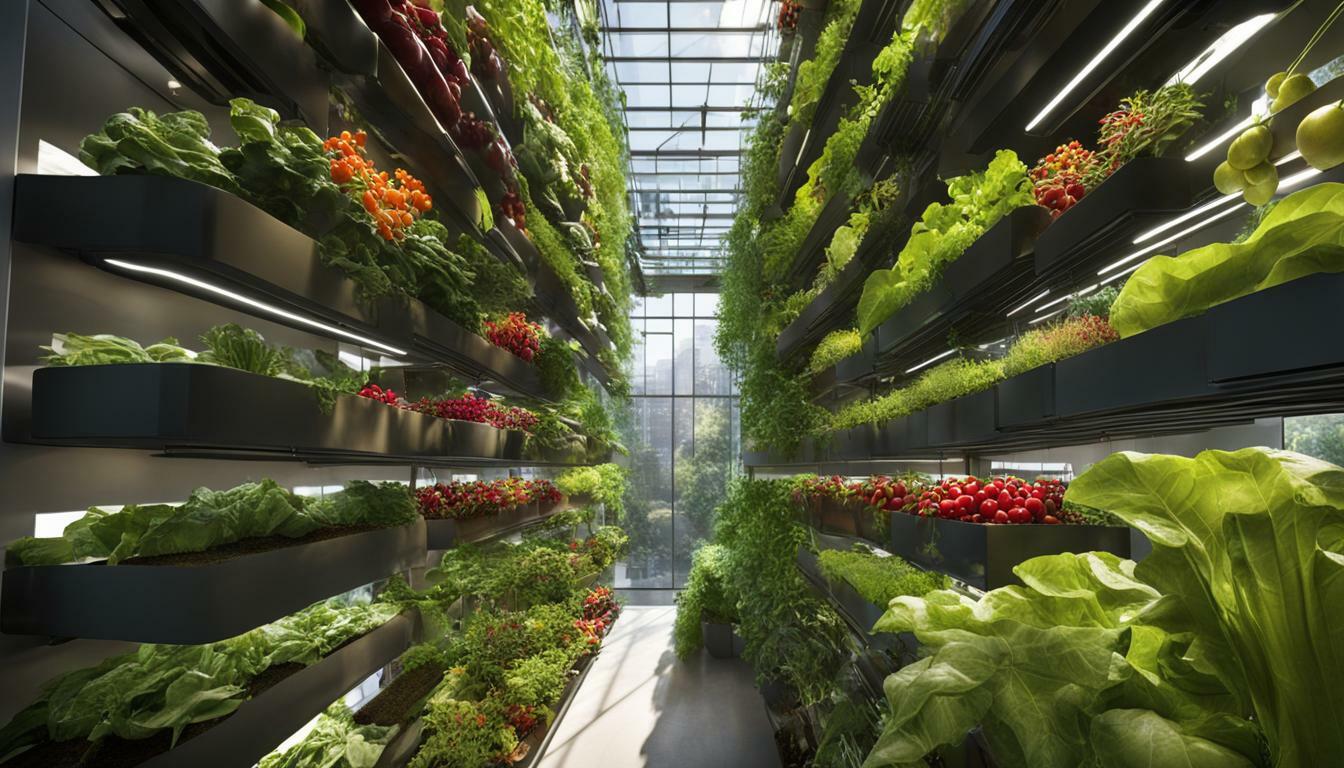Vertical hydroponic gardening is a revolutionary method that allows you to grow a wide variety of plants without soil, using nutrient-rich water solutions and a vertical structure. This innovative gardening technique is gaining popularity due to its space-saving design and eco-friendly approach. Whether you have limited outdoor space or want to bring the beauty of nature indoors, a vertical hydroponic garden can be the perfect solution for your gardening needs.
Key Takeaways:
- Vertical hydroponic gardening enables you to grow plants without soil, using nutrient-rich water solutions and a vertical structure.
- This method is space-saving and ideal for urban environments where outdoor space is limited.
- Vertical hydroponic gardens offer numerous benefits, including water efficiency, faster growth, higher yields, and reduced risks of pests and diseases.
- Essential components of a hydroponic vertical garden include a vertical structure, growing medium, nutrient solution, and water circulation system.
- There are several types of hydroponic vertical garden systems, such as nutrient film technique, aeroponics, drip irrigation, and wick systems.
- Setting up and maintaining a hydroponic vertical garden involves assembling the structure, preparing the plants, mixing the nutrient solution, establishing the water circulation system, and regular monitoring and adjustment.
- Successful hydroponic vertical gardening requires careful plant selection, adequate lighting, monitoring pH and nutrient levels, ensuring proper air circulation, and regular system maintenance.
- Hydroponic vertical gardens can be enhanced with creative ideas, such as creating living walls, using room dividers, making edible art, creating hanging gardens, or designing themed gardens.
- By exploring what you can grow in a vertical hydroponic garden, you can enjoy the benefits of this innovative gardening technique and cultivate a thriving and visually appealing garden.
Understanding Hydroponic Vertical Gardens
Hydroponic vertical gardens merge the concepts of hydroponics and vertical gardening, offering a unique and efficient way to cultivate plants in limited urban spaces. Hydroponics is a method of growing plants in a water-based solution filled with essential nutrients, eliminating the need for soil. Vertical gardening, on the other hand, involves growing plants on a vertical structure, such as a wall or tower, to optimize space utilization.
By combining these techniques, hydroponic vertical gardens provide numerous benefits for urban environments. They maximize space utilization by growing plants vertically, making them ideal for small balconies, backyards, or even indoors. Additionally, hydroponic vertical gardens are highly water-efficient, using up to 90% less water than traditional soil-based gardens. The water is recirculated and reused in a closed-loop system, minimizing waste.
The unique design of hydroponic vertical gardens also promotes faster growth rates and higher yields. With precise control over nutrient delivery and optimal growing conditions, plants can reach their full potential in terms of productivity. Furthermore, the absence of soil in hydroponic systems significantly reduces the risk of pests and diseases, making it easier to maintain a healthy garden.
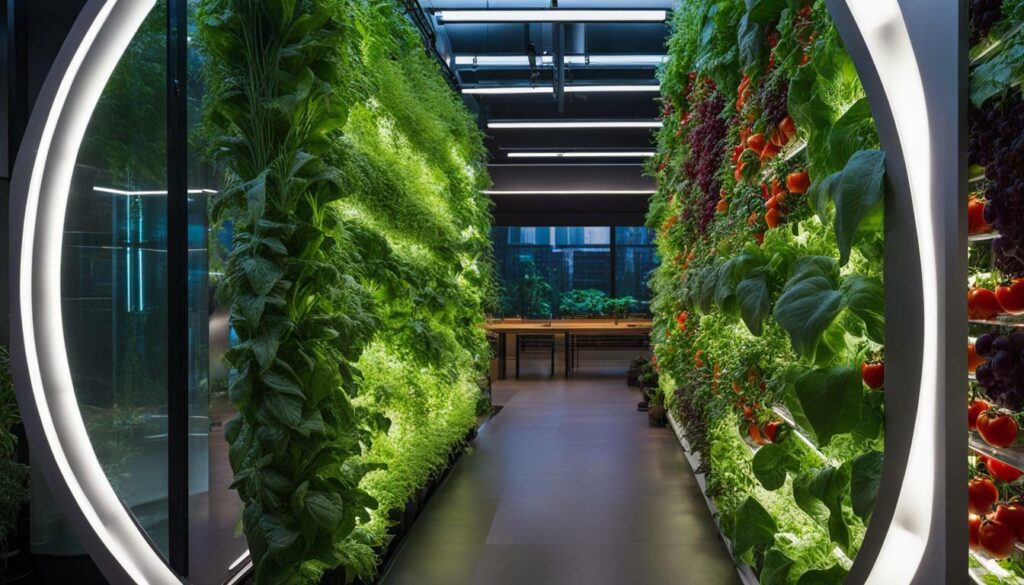
When it comes to hydroponic vertical gardens, several essential components are involved. The vertical structure serves as the framework, providing support for the plants and the weight of the water. Instead of soil, alternative growing mediums like coco coir, perlite, or rockwool anchor the plants and provide necessary support. A carefully formulated nutrient solution delivers essential nutrients, including nitrogen, phosphorus, potassium, and micronutrients. The water circulation system, consisting of a pump, reservoir, and tubing, ensures a continuous flow of nutrient-rich water to the plants.
There are various types of hydroponic systems that can be adapted for vertical gardening. The nutrient film technique (NFT) involves a thin film of nutrient-rich water flowing continuously over the plant roots held in slanted channels. Aeroponics uses a mist or fine spray of nutrient solution to deliver nutrients and moisture directly to the roots. Drip irrigation systems deliver a steady supply of nutrient solution to each plant through a network of tubes and drip emitters. Wick systems, on the other hand, use a passive system where nutrient solution travels from a reservoir to the plants’ roots through absorbent wicks.
Summary:
- Hydroponic vertical gardens merge hydroponics and vertical gardening, maximizing space utilization in urban environments.
- These gardens are water-efficient, using up to 90% less water than traditional soil-based gardens.
- Vertical gardens promote faster growth rates and higher yields due to precise control over nutrient delivery.
- Components of a hydroponic vertical garden include the vertical structure, growing medium, nutrient solution, and water circulation system.
- Various types of hydroponic systems can be adapted for vertical gardening, such as NFT, aeroponics, drip irrigation, and wick systems.
| Benefits | Components | Types of Systems |
|---|---|---|
| Space-saving | Vertical structure | Nutrient film technique (NFT) |
| Water efficiency | Growing medium | Aeroponics |
| Faster growth and higher yields | Nutrient solution | Drip irrigation |
| Fewer pests and diseases | Water circulation system | Wick systems |
Benefits of Hydroponic Vertical Gardens
Hydroponic vertical gardens offer numerous benefits, including space-saving design, water efficiency, faster growth, higher yields, and reduced risks of pests and diseases. These advantages make them an attractive option for urban gardeners, limited space enthusiasts, and those looking for an eco-friendly gardening solution.
One of the primary benefits of hydroponic vertical gardens is their space-saving design. By growing plants vertically, these gardens maximize space utilization, making them ideal for urban dwellers with limited outdoor areas. Whether it’s a small apartment balcony or a tiny backyard, a hydroponic vertical garden allows you to cultivate more plants in a smaller area.
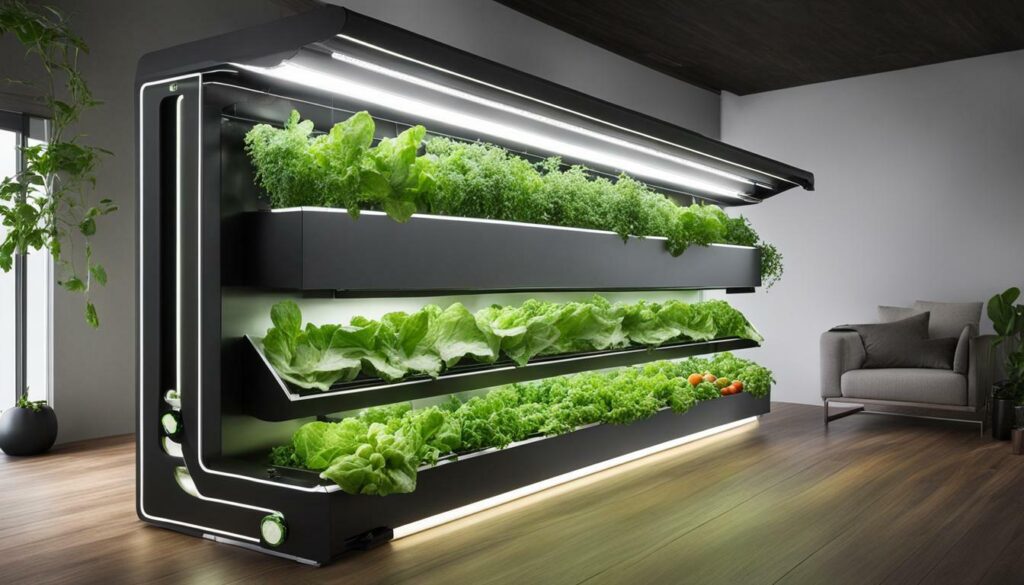
Water efficiency is another key advantage of hydroponic vertical gardens. These systems use up to 90% less water compared to traditional soil-based gardens. The water used in hydroponic systems is recirculated and reused in a closed-loop system, reducing water waste and making them environmentally friendly. This water conservation is particularly important in areas facing water scarcity and drought conditions.
| Advantages of Hydroponic Vertical Gardens |
|---|
| Space-saving design |
| Water efficiency |
| Faster growth |
| Higher yields |
| Fewer pests and diseases |
Faster growth and higher yields are also notable benefits of hydroponic vertical gardens. With precise control over nutrient delivery and optimal growing conditions, plants grown hydroponically tend to grow faster and produce higher yields compared to traditional soil-based gardening. This increased productivity allows gardeners to enjoy a bountiful harvest and satisfy their green thumbs.
Hydroponic vertical gardens also minimize the risks of pests and diseases. As there is no soil involved, the chances of soil-borne pests and diseases are significantly reduced. Additionally, the vertical design of these gardens can act as a natural deterrent to some pests, making it easier to maintain a healthy and pest-free garden. It’s important, however, to regularly monitor the plants for any signs of pests or diseases and take appropriate measures to prevent their spread.
Quotes:
“Hydroponic vertical gardens offer numerous benefits, including space-saving design, water efficiency, faster growth, higher yields, and reduced risks of pests and diseases.”
Summary:
Hydroponic vertical gardens provide several advantages over traditional soil-based gardening. These benefits include space-saving design, water efficiency, faster growth, higher yields, and reduced risks of pests and diseases. With their innovative approach to gardening, hydroponic vertical gardens offer urban dwellers and limited space enthusiasts a practical and sustainable way to grow their own fresh produce.
Components of a Hydroponic Vertical Garden
A hydroponic vertical garden typically consists of a vertical structure, growing medium, nutrient solution, and water circulation system. This innovative gardening technique allows for the cultivation of plants without soil, maximizing space utilization and promoting efficient plant growth.
The vertical structure of a hydroponic vertical garden can take various forms, including wall-mounted panels, freestanding towers, or modular systems. It is essential that the structure is sturdy and capable of supporting the weight of the plants, growing medium, and water.
The growing medium used in hydroponic systems replaces traditional soil and provides support for the plants’ root systems. Commonly used growing media include coco coir, perlite, and rockwool, which offer excellent drainage and aeration properties.
A nutrient solution is a crucial component of hydroponic vertical gardens. This water-based solution is carefully formulated to provide plants with the necessary nutrients for optimal growth. It typically contains essential elements such as nitrogen, phosphorus, potassium, and micronutrients like iron and calcium.
The water circulation system in a hydroponic vertical garden ensures the continuous flow of the nutrient solution to the plants. It consists of a pump, reservoir, and tubing, which deliver the nutrient-rich water to the plants and maintain a closed-loop system. The circulation system plays a vital role in providing plants with the necessary nutrients and maintaining their overall health.
| Component | Description |
|---|---|
| Vertical Structure | Wall-mounted panels, freestanding towers, or modular systems that provide support for the plants and optimize space utilization. |
| Growing Medium | Alternative materials like coco coir, perlite, or rockwool that replace soil and provide support for the plants’ roots. |
| Nutrient Solution | A water-based solution with carefully formulated nutrients that supply plants with essential elements for growth. |
| Water Circulation System | A system consisting of a pump, reservoir, and tubing that ensures a continuous flow of nutrient-rich water to the plants. |
By understanding the components of a hydroponic vertical garden, you can effectively set up and maintain your own system to grow a wide variety of plants without the need for traditional soil-based gardening.
Types of Hydroponic Vertical Garden Systems
There are several types of hydroponic systems that can be adapted for vertical gardening, including nutrient film technique, aeroponics, drip irrigation, and wick systems. Each system has its own unique features and benefits, allowing gardeners to choose the one that best suits their needs and preferences.
Nutrient Film Technique (NFT):
The NFT system involves a thin film of nutrient-rich water flowing continuously over the roots of plants held in slanted channels. This design allows for efficient nutrient delivery and oxygenation, making it suitable for growing leafy greens and herbs. The NFT system ensures that plants have access to the necessary nutrients without being submerged in water.
Aeroponics:
Aeroponic vertical gardens use a mist or fine spray of nutrient solution to deliver nutrients and moisture directly to the plant roots. This method provides excellent oxygenation, promoting rapid growth and high yields. Aeroponic systems are known for their efficiency in water usage and can be highly effective for growing a wide range of plants, including fruits and vegetables.
Drip Irrigation:
In a drip irrigation system, a nutrient solution is delivered to each plant via a network of tubes and drip emitters. This controlled delivery ensures even distribution and minimizes water waste. Drip irrigation systems are commonly used in vertical gardening due to their efficiency and versatility. They can be adapted to different plant types and are suitable for both small-scale home gardens and larger commercial setups.
Wick Systems:
Wick-based vertical gardens use a passive system where the nutrient solution travels from a reservoir to the plants’ roots through absorbent wicks. These low-maintenance systems are ideal for small-scale home gardens and are relatively simple to set up. Wick systems provide a consistent moisture supply to the plants, ensuring their growth and development.
Comparison Table: Types of Hydroponic Vertical Garden Systems
| System | Key Features | Plant Suitability | Water Efficiency | Complexity |
|---|---|---|---|---|
| Nutrient Film Technique (NFT) | Thin film of nutrient-rich water flowing over roots | Leafy greens, herbs | High | Moderate |
| Aeroponics | Mist or fine spray of nutrient solution | Fruits, vegetables, herbs | High | Advanced |
| Drip Irrigation | Nutrient solution delivered through tubes and drip emitters | All plant types | High | Moderate |
| Wick Systems | Passive nutrient delivery through absorbent wicks | All plant types | Low to moderate | Low |
It’s important to note that the choice of hydroponic vertical garden system will depend on factors such as available space, desired plant selection, level of complexity, and personal preference. Each system offers unique advantages and can be customized to meet specific gardening needs.
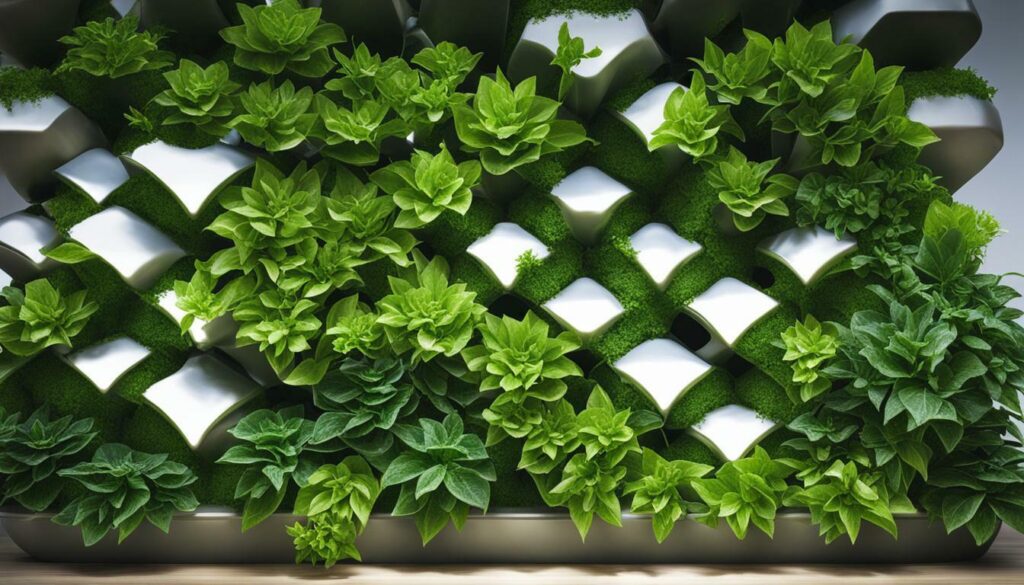
In conclusion, vertical hydroponic gardening offers various system options, including nutrient film technique, aeroponics, drip irrigation, and wick systems. Each system has its strengths and suitability for different plant types. By understanding the features and benefits of these systems, gardeners can choose the one that aligns with their goals and preferences.
Setting Up and Maintaining a Hydroponic Vertical Garden
To set up and maintain a hydroponic vertical garden, follow these steps for structure assembly, plant preparation, nutrient solution mixing, water circulation system establishment, and regular monitoring and adjustment.
Structure Assembly
The first step in setting up a hydroponic vertical garden is to assemble the structure. Whether you choose wall-mounted panels, freestanding towers, or modular systems, make sure to follow the manufacturer’s instructions carefully. The structure should be sturdy and able to support the weight of the plants, growing medium, and water. Proper assembly is essential for the stability and longevity of your vertical garden.
Plant Preparation
Once the structure is in place, it’s time to prepare the plants for your hydroponic vertical garden. Transplant seedlings or cuttings into the chosen growing medium, taking care not to damage the delicate roots. Gently insert the plants into the designated slots or containers within the vertical structure. Ensure that each plant has enough space to grow without crowding or blocking sunlight from neighboring plants.
Nutrient Solution Mixing
A crucial aspect of hydroponic gardening is providing the plants with the necessary nutrients for growth. Mix the appropriate nutrient solution according to the instructions provided by the manufacturer or based on the specific needs of your plants. The nutrient solution typically includes essential macronutrients like nitrogen, phosphorus, and potassium, as well as micronutrients. Regularly monitor the pH and nutrient levels of the solution and make adjustments as needed to maintain optimal plant health.
Water Circulation System Establishment
The water circulation system is vital for delivering the nutrient-rich solution to your plants. Connect the pump, tubing, and reservoir to create a closed-loop system that ensures a continuous flow of water and nutrients. The pump should circulate the nutrient solution through the tubing, delivering it to the plants at regular intervals. Proper water circulation helps the plants absorb the nutrients they need for healthy growth and prevents stagnation or nutrient deficiencies.
Monitoring and Adjustment
Regular monitoring is essential to ensure the success of your hydroponic vertical garden. Check the pH and nutrient levels of the solution regularly using appropriate testing kits. Monitor the overall health and growth of your plants, looking for signs of nutrient deficiencies or pests. Adjust the nutrient solution concentration or pH as needed to maintain optimal conditions for plant growth. Prune and harvest plants as necessary to prevent overcrowding and promote healthy airflow.
Tips: Keep a record of your observations and adjustments to track the progress of your hydroponic vertical garden. Regularly clean and maintain the system to prevent clogs or buildup of algae or debris. Consider using timers or automated systems to ensure consistent watering and nutrient delivery. With proper monitoring and adjustment, your hydroponic vertical garden can thrive and provide a bountiful harvest.
Table: Essential Steps for Setting Up and Maintaining a Hydroponic Vertical Garden
| Step | Description |
|---|---|
| Structure Assembly | Follow manufacturer’s instructions to assemble the vertical garden structure |
| Plant Preparation | Transplant seedlings or cuttings into the growing medium within the vertical structure |
| Nutrient Solution Mixing | Mix nutrient solution according to manufacturer’s instructions or plant requirements |
| Water Circulation System Establishment | Connect pump, tubing, and reservoir to create a closed-loop water circulation system |
| Monitoring and Adjustment | Regularly monitor pH, nutrient levels, and plant health; make adjustments as necessary |
Setting up and maintaining a hydroponic vertical garden requires careful attention to detail, but the rewards are well worth the effort. By following these steps and implementing proper monitoring and adjustment, you can enjoy the benefits of growing healthy, thriving plants in a compact and efficient space.
Tips for Successful Hydroponic Vertical Gardening
To ensure successful hydroponic vertical gardening, consider plant selection, lighting requirements, pH and nutrient level monitoring, air circulation, and regular system maintenance. These factors play a crucial role in the health and productivity of your vertical garden.
Plant Selection
Choose plants that are well-suited for vertical hydroponic gardening. Opt for varieties with shallow root systems, such as leafy greens, herbs, and small fruiting plants like strawberries. These plants are more adaptable to the limited vertical growing space and can thrive without soil.
It’s also essential to consider the growth characteristics of the plants you choose. Some plants tend to grow taller or wider than others, so make sure they can be accommodated within your vertical structure. This will prevent overcrowding and ensure optimal growth and access to light and nutrients.
Lighting Requirements
Provide adequate lighting for your hydroponic vertical garden. Most plants require at least 6-8 hours of direct or indirect sunlight daily for optimal growth. If you’re growing indoors or in a shaded area, consider using artificial grow lights to supplement natural light.
LED grow lights are highly recommended for their energy efficiency and ability to provide the specific light spectrum that plants need for photosynthesis. Position the lights at an appropriate distance from the plants to avoid heat stress or light burn.
pH and Nutrient Level Monitoring
Maintaining the right pH and nutrient levels is crucial for the health and productivity of your plants. Hydroponic systems typically require a slightly acidic pH level in the range of 5.5-6.5 for optimal nutrient uptake. Test the pH regularly using an electronic pH meter or test strips and adjust as needed using pH-up or pH-down solutions.
Monitor the nutrient levels in your solution using an electrical conductivity (EC) meter or nutrient test kits. Nutrient deficiencies or excesses can impact plant growth and productivity. Follow the instructions provided by the nutrient manufacturer to ensure proper nutrient concentration.
Air Circulation
Proper air circulation is essential for preventing mold, mildew, and pests in your hydroponic vertical garden. Ensure good air exchange by providing adequate ventilation or using fans to circulate air. This helps prevent stagnant air and maintains optimal humidity levels.
Placing fans strategically near the plants can also strengthen their stems and promote sturdy growth. Be mindful of the placement of the fans to avoid excessive drying of plants or causing damage.
Regular System Maintenance
Maintaining your hydroponic vertical garden requires regular attention and care. Keep the system clean by regularly removing debris and algal growth. Clean the reservoir, tubing, and other components to prevent clogs and ensure proper water circulation.
Inspect the system for any signs of damage or leaks and make necessary repairs. Prune and harvest your plants regularly to remove any dead or decaying foliage. This promotes healthy growth and prevents the spread of pests and diseases.
| Tip | Description |
|---|---|
| Choose the right plants | Opt for plants with shallow root systems that are adaptable to vertical growing. |
| Provide adequate lighting | Ensure plants receive at least 6-8 hours of direct or indirect sunlight or use LED grow lights. |
| Monitor pH and nutrient levels | Regularly test and adjust pH and nutrient levels to maintain optimal plant health. |
| Maintain proper air circulation | Ensure good ventilation and use fans to promote air exchange and prevent pests and diseases. |
| Regular system maintenance | Clean the system, inspect for damage, and prune and harvest plants regularly. |
By following these tips and monitoring the needs of your plants, you can create a successful hydroponic vertical garden that yields bountiful harvests year-round.
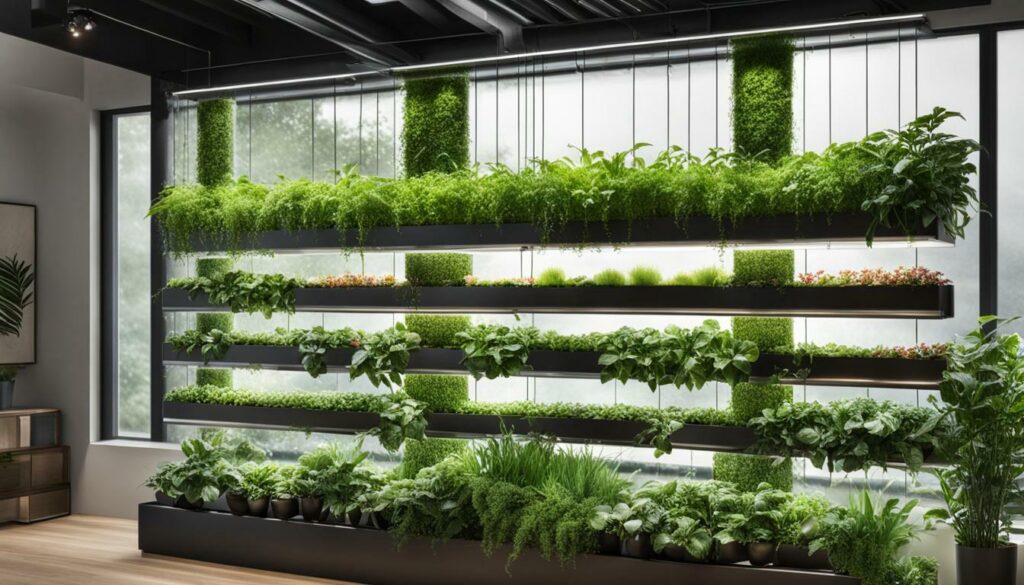
Creative Ideas for Hydroponic Vertical Gardens
Hydroponic vertical gardens can be creatively designed as living walls, room dividers, edible art, hanging gardens, or themed gardens. These innovative ideas not only add visual appeal to your space but also maximize the functionality of your hydroponic system. Let’s explore some creative ideas for hydroponic vertical gardens:
Living Walls
Transform an outdoor or indoor wall into a lush, green oasis with a hydroponic vertical garden. By incorporating a variety of plants in different sizes and colors, you can create a stunning living wall that adds natural beauty to any space. Whether you choose to cover an entire wall or create a smaller focal point, a living wall will make a striking statement.
Room Dividers
Use a freestanding hydroponic system to create a natural room divider in open living spaces. By positioning the vertical garden in the middle of a room, you can create a visually appealing partition while still allowing light and air to flow through. This not only adds a touch of greenery but also creates a sense of privacy and separation.
Edible Art
Arrange your plants in patterns or shapes to create an edible piece of art. With careful planning and selection of different colored and textured plants, you can create visually stunning designs that are not only beautiful but also delicious. Imagine growing herbs in the shape of a heart or arranging different lettuces to spell out words. Edible art adds a unique touch to your hydroponic vertical garden.
Hanging Gardens
Suspend small hydroponic containers from the ceiling to create a hanging garden. This is a great option for those with limited floor space or for adding a touch of greenery to awkward spaces such as stairwells or high ceilings. By using hanging baskets or specialized hanging systems, you can create a stunning display of plants that cascades down from above, adding visual interest and a sense of depth to your space.
Themed Gardens
Design your hydroponic vertical garden around a specific theme to create a unique and immersive experience. Whether it’s a culinary herb garden, a salad garden, or a tropical plant display, themed gardens allow you to customize your space according to your interests and preferences. By selecting plants that match the theme and incorporating decorative elements, you can create a mini oasis that transports you to a different world.
These creative ideas for hydroponic vertical gardens offer endless possibilities for enhancing your space and making your hydroponic garden a visually stunning and functional feature. Whether you choose to create a living wall, a room divider, edible art, hanging gardens, or a themed garden, the key is to let your creativity shine and design a space that reflects your personality and style.
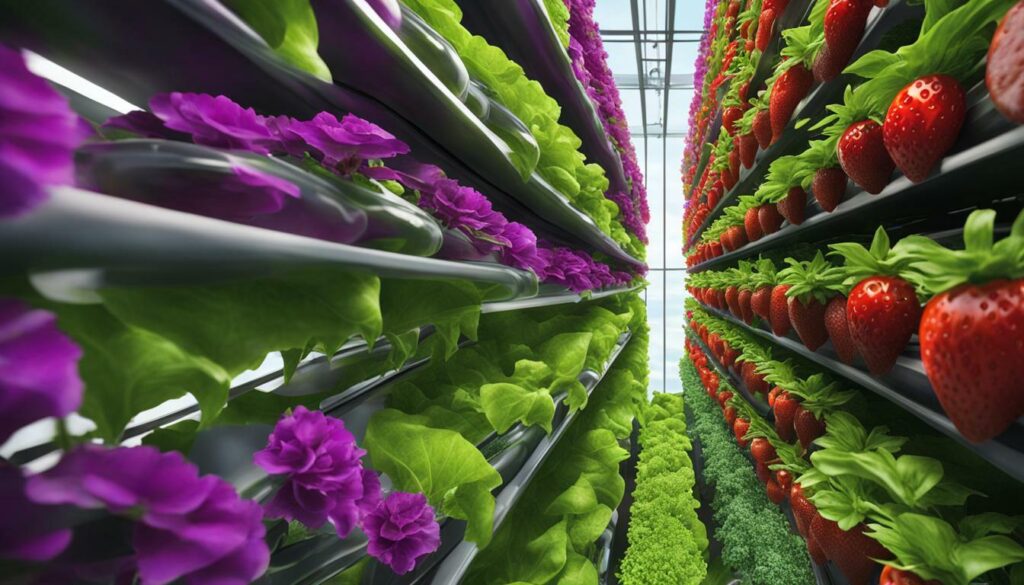
| Benefits | Types | Components | Tips |
|---|---|---|---|
| Space-saving | Nutrient Film Technique (NFT) | Vertical structure | Choose the right plants |
| Water efficiency | Aeroponics | Growing medium | Provide adequate lighting |
| Faster growth and higher yields | Drip irrigation | Nutrient solution | Monitor pH and nutrient levels |
| Fewer pests and diseases | Wick systems | Water circulation system | Maintain proper air circulation |
“Hydroponic vertical gardens can transform any space into a green oasis.” – Expert Gardener
Conclusion
In conclusion, hydroponic vertical gardens provide a unique and efficient way to grow a wide variety of plants in limited urban spaces, offering numerous benefits over traditional soil-based gardening methods. By understanding the components, types of systems, and maintenance tips, you can successfully explore the exciting possibilities of what you can grow in a vertical hydroponic garden.
Hydroponic vertical gardens combine the concepts of hydroponics and vertical gardening to maximize space utilization and create a sustainable and eco-friendly gardening technique. With their space-saving design, these gardens are perfect for urban dwellers with limited space, allowing them to grow their own fresh produce indoors or on small balconies.
One of the key advantages of hydroponic vertical gardens is their water efficiency. These systems use up to 90% less water than traditional soil-based gardens because the water is recirculated and reused, reducing water consumption and minimizing waste. This makes them a sustainable choice for water-conscious gardeners.
Furthermore, hydroponic vertical gardens offer faster growth and higher yields compared to traditional gardening methods. By providing plants with the optimal nutrient balance and growing conditions, these gardens promote healthy and robust growth, resulting in bountiful harvests.
In addition, hydroponic vertical gardens are less susceptible to pests and diseases. Without soil, the risk of soil-borne pests and diseases is significantly reduced. The vertical design can also help deter pests, making it easier to maintain a healthy and pest-free garden.
Setting up a hydroponic vertical garden involves several key components, including the vertical structure, growing medium, nutrient solution, and water circulation system. These elements work together to create an efficient and self-contained system that supports plant growth and maximizes space utilization.
There are several types of hydroponic systems that can be adapted for vertical gardening, such as the nutrient film technique, aeroponics, drip irrigation, and wick systems. Each system has its advantages and is suitable for different types of plants and growing conditions.
To successfully maintain a hydroponic vertical garden, it’s important to follow proper setup and maintenance procedures. This includes assembling the structure, preparing the plants, mixing the nutrient solution, establishing the water circulation system, and regularly monitoring and adjusting the pH and nutrient levels.
By following these tips and guidelines, you can ensure the success of your hydroponic vertical garden and enjoy the benefits of fresh and homegrown produce. Additionally, you can get creative with your garden design and explore different ideas, such as creating living walls, using room dividers, making edible art, creating hanging gardens, or designing themed gardens.
With hydroponic vertical gardens, you have the opportunity to grow a wide range of vegetables, herbs, and fruits. The possibilities are endless, and the benefits are numerous. So, why not embrace this innovative gardening technique and start growing your own vertical hydroponic garden today?
Can the Same Crops be Grown in Both Indoor and Outdoor Vertical Hydroponic Gardens?
Yes, the same crops can be grown in both indoor and outdoor vertical hydroponic gardens. With the right setup, nutrient delivery, and environmental control, plants like lettuce, tomatoes, and herbs thrive in an outdoor vertical hydroponic garden just as they would indoors.
FAQ
Q: What is a hydroponic vertical garden?
A: A hydroponic vertical garden is a gardening method that combines hydroponics and vertical gardening. It allows plants to be grown without soil using a nutrient-rich water solution and a vertical structure.
Q: What are the benefits of hydroponic vertical gardens?
A: Hydroponic vertical gardens offer space-saving design, water efficiency, faster growth, higher yields, and reduced risks of pests and diseases compared to traditional soil-based gardening.
Q: What are the components of a hydroponic vertical garden?
A: A hydroponic vertical garden consists of a vertical structure, growing medium, nutrient solution, and water circulation system.
Q: What are the types of hydroponic vertical garden systems?
A: Some popular types of hydroponic vertical garden systems include nutrient film technique (NFT), aeroponics, drip irrigation, and wick systems.
Q: How do you set up and maintain a hydroponic vertical garden?
A: To set up a hydroponic vertical garden, you need to assemble the structure, prepare the plants, mix the nutrient solution, establish the water circulation system, and regularly monitor and adjust pH and nutrient levels. Maintenance includes pruning and harvesting as necessary.
Q: What are some tips for successful hydroponic vertical gardening?
A: Tips for successful hydroponic vertical gardening include choosing the right plants, providing adequate lighting, monitoring pH and nutrient levels, maintaining proper air circulation, and keeping the system clean.
Q: What are some creative ideas for hydroponic vertical gardens?
A: Creative ideas for hydroponic vertical gardens include creating living walls, using them as room dividers, arranging plants in patterns or shapes for edible art, creating hanging gardens, and designing themed gardens.

